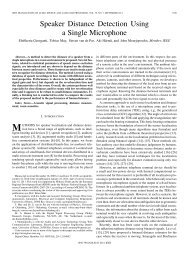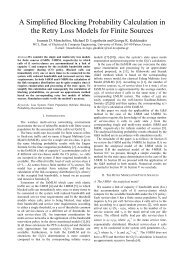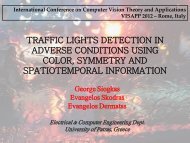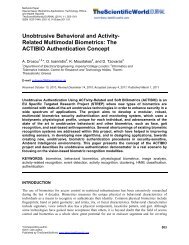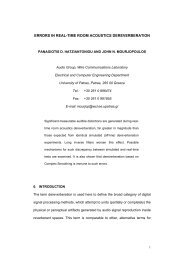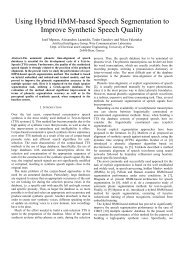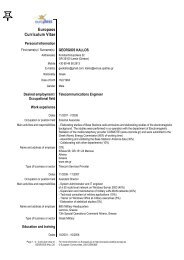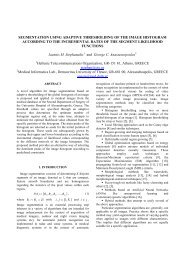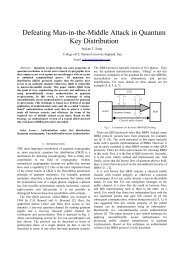BlueBox: A cable-free Digital Jukebox for compressed-quality Audio ...
BlueBox: A cable-free Digital Jukebox for compressed-quality Audio ...
BlueBox: A cable-free Digital Jukebox for compressed-quality Audio ...
You also want an ePaper? Increase the reach of your titles
YUMPU automatically turns print PDFs into web optimized ePapers that Google loves.
<strong>BlueBox</strong>: A <strong>cable</strong>-<strong>free</strong> <strong>Digital</strong> <strong>Jukebox</strong> <strong>for</strong><br />
<strong>compressed</strong>-<strong>quality</strong> <strong>Audio</strong> Delivery<br />
Andreas Floros, Nicolas – Alexander Tatlas and John Mourjopoulos<br />
Abstract — The recent growth of home networking<br />
applications has raised the requirement <strong>for</strong> <strong>cable</strong>-<strong>free</strong><br />
distribution of an increasing amount of media to portable<br />
playback devices, which lack the resources <strong>for</strong> local storage.<br />
In this work, the “<strong>BlueBox</strong>” wireless digital jukebox<br />
application is presented, which employs the Bluetooth<br />
wireless technology <strong>for</strong> distributing on demand, high-<strong>quality</strong><br />
<strong>compressed</strong> audio, originally stored in a Bluetooth-enabled<br />
digital jukebox to remote portable client devices. It is shown<br />
that despite the strict throughput limitations imposed by the<br />
early-defined Bluetooth protocols, the <strong>BlueBox</strong> application<br />
setup can efficiently accommodate <strong>cable</strong>-<strong>free</strong>, high-<strong>quality</strong><br />
audio distribution over an adequate number of receivers <strong>for</strong><br />
home environments 1 .<br />
Index Terms — Wireless audio, real-time playback, Bluetooth<br />
player.<br />
I. INTRODUCTION<br />
Compressed-<strong>quality</strong> audio such as MPEG1-Layer 3 (mp3)<br />
is an extremely popular digital audio <strong>for</strong>mat today [1], with a<br />
vast number of audio tracks available <strong>for</strong> download over the<br />
internet, through subscriber services or even peer-to-peer<br />
networks. In spite of the availability of solid-state memory<br />
and hard drive-equipped <strong>compressed</strong>-audio portable players,<br />
storage of mp3 files is still intrinsically tied to the Personal<br />
Computer (PC). Most portable audio players come equipped<br />
with a wired interface, such as the Universal Serial Bus (USB)<br />
or IEEE1394, allowing the direct transfer of files from a PC.<br />
While home networking applications are constantly evolving<br />
over the last years, the possibility of streaming directly the<br />
audio content to a portable player <strong>for</strong> immediate playback<br />
over a network is generally under research. A number of<br />
system prototypes have been designed lately offering<br />
streaming capabilities over typical networking protocols,<br />
however wireless audio streaming to portable devices is not<br />
yet exploited.<br />
On the other hand, wireless networks are becoming a<br />
necessity these days, meeting the need <strong>for</strong> a <strong>cable</strong>-<strong>free</strong> but<br />
networked environment. Several Wireless Local Area<br />
Networks (WLANs) protocols have been standardized and are<br />
broadly employed, such as the IEEE802.11b/g [2] operating in<br />
the 2.4GHz band, providing hi-speed communication with<br />
data rates up to 54Mbps. WLANs are able to offer wideband<br />
wireless connectivity between Desktop PCs, Laptops,<br />
Personal <strong>Digital</strong> Assistants (PDAs), and other portable<br />
electronic devices <strong>for</strong> voice, video and data applications.<br />
In the area of Personal Area Networks (PANs) where the<br />
low power consumption and the reduced complexity and cost<br />
are prime objectives <strong>for</strong> the design and development of<br />
portable, self-powered devices, Bluetooth [3] represents a<br />
widely-adopted wireless technology operating mainly in<br />
home, office and automotive environments. Although this<br />
technology was initially developed <strong>for</strong> replacing <strong>cable</strong>s, it<br />
evolved into a way to create small radio LANs.<br />
The Bluetooth specification defines synchronous<br />
connection- oriented mechanisms <strong>for</strong> servicing time-critical<br />
applications (<strong>for</strong> example voice and audio) at a reserved<br />
constant rate equal to 64kbps. However, this limited<br />
bandwidth per<strong>for</strong>mance represents a major drawback even <strong>for</strong><br />
<strong>compressed</strong>-<strong>quality</strong> digital audio delivery. Hence, packetoriented<br />
(or asynchronous) connections can alternatively be<br />
employed, provided that the physical layer offers sufficient<br />
bandwidth (at least equal to the maximum encoding bit rate)<br />
[4].<br />
This work presents the development and employment of a<br />
set of client-server applications that facilitate wireless digital<br />
audio streaming to portable devices from a server PC using<br />
the Bluetooth v1.2 protocol specification [5]. Section 1<br />
outlines the Bluetooth protocol basic operations and features.<br />
In Section 2 the <strong>BlueBox</strong> jukebox server and client<br />
applications are presented in detail. In Section 3 the<br />
employment of these applications <strong>for</strong> a typical audio delivery<br />
setup implementation is described, leading to the measured<br />
results Section 4. Finally, the conclusions are summarized in<br />
Section 5.<br />
II. BLUETOOTH OVERVIEW<br />
Bluetooth-enabled devices employ an embedded radio<br />
module operating in the ISM (Industrial Scientific Medicine)<br />
frequency band in the range of 2.4GHz. In order to operate in<br />
the presence of electromagnetic interference and fading, a<br />
frequency-hopping algorithm is employed which theoretically<br />
achieves a total bandwidth equal to 1Mbps within a typical<br />
distance of 10 meters. This range can be extended up to 100<br />
meters <strong>for</strong> Bluetooth class 1 devices, which incorporate RF<br />
modules that provide larger transmission power, equal to<br />
20dBm.<br />
A Bluetooth piconet typically consists of a master device<br />
(or node), which is connected with a number (maximum<br />
seven) of slave devices (Fig. 1). As Bluetooth was initially<br />
designed to service both data and real-time traffic<br />
transmissions, it supports both asynchronous and isochronous
services through two different types of links: (a) point-topoint<br />
or point-to-multipoint Asynchronous Connection-Less<br />
(ACL) links and (b) Synchronous Connection Oriented (SCO)<br />
point-to-point links. When using an ACL link, a “slotted”<br />
channel is applied with a slot time equal to 625μseconds,<br />
while a Time-Division Duplex (TDD) scheme is employed <strong>for</strong><br />
full duplex transmissions. A packet transmission can cover up<br />
to 5 channel slots. The packet-oriented transmissions through<br />
the ACL links can achieve a maximum of 721kbps effective<br />
bitrate and can be acknowledged through a retransmission<br />
mechanism. However, in the presence of excessive channel<br />
interference, packet retransmissions significantly degrade the<br />
above throughput per<strong>for</strong>mance.<br />
can be found as embedded firmware, to assure lower power<br />
consumption and implementation complexity.<br />
Fig. 2: Block diagram of the Bluetooth layer stack<br />
Fig. 1: Typical Bluetooth piconet setup<br />
ACL connections support two packet types: Data-Medium<br />
rate (DM) and Data-High rate (DH) packets, with the <strong>for</strong>mer<br />
additionally containing Forward Error Correction (FEC)<br />
in<strong>for</strong>mation. The Bluetooth specification defines three types<br />
of DM packets (named as DM1, DM3 and DM5). A DM1<br />
packet length is limited to a single channel slot, while DM3<br />
and DM5 packets are extended to 3 and 5 channel slots<br />
respectively. DH1, DH3 and DH5 packet lengths are also<br />
defined accordingly. ACL links can accommodate both pointto-point<br />
and point-to-multipoint (or broadcast) packet<br />
transmissions.<br />
As it is shown in Fig. 2, the Bluetooth specification defines<br />
the Bluetooth protocol stack in layers, in common with all the<br />
well established wired and wireless networking protocols.<br />
More specifically, the Bluetooth lower layer stack consists of<br />
(a) the 2.4GHz radio (RF) layer that implement the physical<br />
transmission and reception interface (b) The baseband or link<br />
control layer that realizes the timing, ordering and sequencing<br />
of the transmitted bits, including channel coding and (c) The<br />
link manager layer, which manages the behavior of the<br />
wireless link and implements service discovery procedures<br />
between Bluetooth-enabled devices, that are in range. The<br />
upper part of the link manager co-operates with the Host<br />
Controller Interface (HCI) and the Logical Link Control and<br />
Adaptation Layer (L2CAP) <strong>for</strong> providing higher layer<br />
protocol services, such as data multiplexing and packet<br />
segmentation and reassembly. Both the link manager and HCI<br />
layers are usually implemented as software modules, but often<br />
The Bluetooth specification also introduces the concept of<br />
profiles. A profile is a selection of procedures and messages<br />
that extend the basic application level Bluetooth functionality<br />
and assure interoperability between the remote services. For<br />
audio-oriented applications, several profiles have been already<br />
defined (such as the Generic <strong>Audio</strong>/Video Distribution Profile<br />
– GAVDP [6] and the Advanced <strong>Audio</strong> Distribution Profile –<br />
A2DP [7]), which define procedures <strong>for</strong> establishing<br />
audio/video streaming applications and basic <strong>compressed</strong><br />
<strong>quality</strong> transmission over Bluetooth.<br />
A previous work [8] has defined the basic framework <strong>for</strong><br />
transmitting <strong>compressed</strong> <strong>quality</strong> audio over Bluetooth using<br />
both point-to-point and point-to-multipoint transmissions<br />
through ACL links. This work has also assessed the overall<br />
per<strong>for</strong>mance achieved during the wireless audio transmissions<br />
as a function of the Bluetooth protocol parameters (e.g. the<br />
packet length and type, etc). The transmission optimizations<br />
derived from this work were employed here in order to<br />
efficiently develop the <strong>BlueBox</strong> wireless digital jukebox<br />
application, which is described in the next Section.<br />
III. BLUEBOX APPLICATION OVERVIEW<br />
The <strong>BlueBox</strong> jukebox architecture (see Fig. 3) is based on<br />
the well-established server-client model. An application<br />
running on the server side (i.e. the <strong>BlueBox</strong> server) is<br />
responsible <strong>for</strong> handling the stored media lists and <strong>for</strong><br />
establishing wireless Bluetooth connections with the remote<br />
client devices. These devices are controlled by the <strong>BlueBox</strong><br />
client application, which realizes the interface <strong>for</strong> all the basic<br />
user operations, such as track selection and playback control,<br />
connection and disconnection from the server etc. A detailed<br />
description of both applications is provided in the following<br />
paragraphs.<br />
A. The <strong>BlueBox</strong> Server application architecture<br />
The <strong>BlueBox</strong> server application is typically hosted on a<br />
Bluetooth-enabled PC in master mode, with sufficient disc
space <strong>for</strong> storing audio media. A special, user friendly<br />
procedure was designed and developed <strong>for</strong> easily organizing<br />
the audio content locally stored on the jukebox server side in<br />
play-lists. Provided that a Bluetooth connection is successfully<br />
established between the server and a remote client device and<br />
upon a user request, a specific, user-selected track is<br />
transmitted to the <strong>BlueBox</strong> client application and is<br />
reproduced in real-time.<br />
Due to the bandwidth limitations of the Bluetooth protocol,<br />
only <strong>compressed</strong> <strong>quality</strong> audio can be serviced. Currently, the<br />
MPEG1 Layer III (mp3) and the Windows Media <strong>Audio</strong><br />
(WMA) <strong>for</strong>mats are supported with data rates up to 320kbps<br />
in mono, stereo and joint stereo modes. Compact Disc <strong>quality</strong><br />
media can be also employed (2 audio channels with bit<br />
resolution equal to 16bit and sampling frequency 44.1kHz),<br />
but in this case, the digital audio data are <strong>compressed</strong> in realtime<br />
using the MPEG1 Layer III standard at 128kbps, prior to<br />
the wireless transmission.<br />
play_list<br />
audio_data<br />
Transmitter<br />
Software<br />
Bluetooth<br />
Device<br />
status_info<br />
ACL<br />
user_request<br />
<strong>Audio</strong><br />
Player<br />
<strong>Audio</strong><br />
processing<br />
<strong>Audio</strong><br />
decoder<br />
<strong>BlueBox</strong><br />
Server<br />
audio_data<br />
ACL<br />
User<br />
Interface<br />
user_request<br />
play_list<br />
Receiver<br />
Software<br />
ACL<br />
<strong>BlueBox</strong><br />
Client<br />
audio_data<br />
play_list<br />
ACL<br />
audio<br />
subsystem<br />
Fig. 3: Architecture of the <strong>BlueBox</strong> application<br />
user_request<br />
Bluetooth<br />
Device<br />
As it is shown in Fig. 3, after the successful ACL<br />
connection establishment with a <strong>BlueBox</strong> client device, the<br />
<strong>BlueBox</strong> server automatically transmits the available music<br />
track titles (play_list data) contained in the user defined play<br />
list through the wireless link. All Bluetooth transmissions are<br />
per<strong>for</strong>med using DH5 packets, unless otherwise stated. The<br />
audio data (audio_data) that correspond to a specific audio<br />
track contained in the play-list are also transmitted through the<br />
same link upon a remote user request. As it will be explained<br />
in the next Section, these requests are initiated on the <strong>BlueBox</strong><br />
client side and transmitted through the bi-directional ACL link<br />
(user_request traffic flow) using a custom-defined protocol<br />
developed in this work. This protocol also defines the<br />
necessary signaling <strong>for</strong> supporting a complete set of playback<br />
control functions, such as stop, pause etc, as well as the<br />
procedures <strong>for</strong> distributing the available play-list and it’s<br />
updates to all the connected devices.<br />
The <strong>BlueBox</strong> server must be able to service more than one<br />
remote clients simultaneously. For this reason, data<br />
transmissions are controlled by a transmitter software module,<br />
which is responsible <strong>for</strong> coordinating the transmissions above<br />
the Bluetooth stack layer. For example, each time a playback<br />
initiation request is received from a client <strong>for</strong> a specific track,<br />
this module initiates a thread that per<strong>for</strong>ms the audio data<br />
delivery by sending the data packets to the Bluetooth device.<br />
The transmitter software module controls the execution of<br />
all the active transmission threads and synchronizes them in<br />
order to meet the necessary bandwidth requirements <strong>for</strong> the<br />
audio data transmissions, taking into account packets<br />
transmitted periodically by the clients (status_info traffic<br />
flow) containing in<strong>for</strong>mation about the playback status. More<br />
specifically, in order to avoid any data overflows on the<br />
remote client reception buffers, if the bandwidth allocated <strong>for</strong><br />
a specific audio stream exceeds the value required <strong>for</strong> error<strong>free</strong>,<br />
uncorrupted playback, the thread execution is blocked.<br />
On the other hand, if many remote clients request service<br />
and/or under heavy channel interference, the data delivery to<br />
one or more clients will be delayed and the playback<br />
(reception) buffer will get empty, causing audible playback<br />
interrupts.<br />
As concurrent transmissions and/or reception may occur <strong>for</strong><br />
the above transmitted data types (audio_data, status_info and<br />
user_request), the Bluetooth L2CAP layer is employed <strong>for</strong><br />
creating logical data channels and efficiently multiplexing the<br />
transmitted data flows through the same bi-directional ACL<br />
link. It should be noted that, although the choice of the<br />
L2CAP layer reduces the overall <strong>BlueBox</strong> application<br />
complexity (as all the required multiplexing functionality is<br />
realized in the Bluetooth lower stack), as it was concluded in<br />
[8], it’s presence in the transmission chain may significantly<br />
affect the effective bitrate measured on the application level.<br />
Hence the maximum number of the remote clients that can be<br />
concurrently serviced is somehow decreased.<br />
B. The <strong>BlueBox</strong> client application architecture<br />
As it is illustrated in Fig. 3, the <strong>BlueBox</strong> client application<br />
consists of three basic modules: (a) The interface with the<br />
wireless sub-system (Receiver Software) that is responsible<br />
<strong>for</strong> receiving data packets from the Bluetooth transceiver and<br />
<strong>for</strong> sending playback control messages (status_info) back to<br />
the server (b) the User Interface that locally stores the<br />
received play-list and initiates any user requests following the<br />
user actions and options and (c) the audio sub-system which<br />
decodes the received <strong>compressed</strong> audio packets, processes the<br />
de<strong>compressed</strong> audio data and drives them to the audio<br />
playback sub-system (e.g. the PC soundcard).<br />
More specifically, upon the successful establishment of a<br />
Bluetooth connection with the <strong>BlueBox</strong> server, the client<br />
application receives the play-list data. The in<strong>for</strong>mation<br />
contained in this play-list is used <strong>for</strong> mapping the track
selected by the user to an original track identifier (TrackID)<br />
stored on the <strong>BlueBox</strong> server side. This mapping is per<strong>for</strong>med<br />
by the custom protocol running on the application layer,<br />
which is also responsible <strong>for</strong> all the signaling and control<br />
in<strong>for</strong>mation exchange between the server and the remote<br />
clients. Upon a track selection, an appropriate message is<br />
transmitted to the server, which contains the unique TrackID<br />
that corresponds to the specific track. After the successful<br />
reception of this message, the <strong>BlueBox</strong> server starts<br />
transmitting the <strong>compressed</strong> audio data to the requesting<br />
client.<br />
In order to minimize the effects of the variable channel<br />
conditioning (especially in the presence of strong<br />
electromagnetic interference which would increase the<br />
number of retransmissions required <strong>for</strong> safe wireless delivery),<br />
audio data pre-buffering is per<strong>for</strong>med. The pre-buffering<br />
length id equal to 2 seconds, meaning that the playback will<br />
start 2 seconds after the first audio data packet reception by<br />
the client. Provided that the highest audio data rate equals to<br />
320kbps, the minimum length of the memory required <strong>for</strong> prebuffering<br />
purposes equals to 80kBytes. In this work, and <strong>for</strong><br />
safety reasons, the length of the receiver buffer was equal to<br />
100kBytes.<br />
transmissions. However it is obvious that if the total requested<br />
bandwidth from the remote players exceeds the total available,<br />
buffer under-run errors will occur to at least one player,<br />
causing audible distortion in the reproduction.<br />
Fig 4.: <strong>BlueBox</strong> server main window<br />
IV. BLUEBOX APPLICATION IMPLEMENTATION<br />
The <strong>Jukebox</strong> client-server applications were developed<br />
using the C++ programming language. The <strong>BlueBox</strong> server<br />
can run on any Bluetooth-enabled PC having sufficient hard<br />
disk space <strong>for</strong> audio storage, while two versions of the<br />
<strong>BlueBox</strong> Player were implemented: one <strong>for</strong> desktop PCs and<br />
one <strong>for</strong> PDAs and Pocket PC devices. Both the PC and Pocket<br />
PC versions were designed to provide exactly the same<br />
functionality described here.<br />
In order to setup a test topology, a typical office PC was<br />
employed as the <strong>Jukebox</strong> server, while a typical notebook and<br />
a PDA were used as <strong>BlueBox</strong> clients. The Bluetooth adapters<br />
used were based on a proprietary single chip solution<br />
baseband controller [9] with PCMCIA physical interface,<br />
connected with Class 3/0 dBm RF modules.<br />
Fig. 4 shows the main window of the <strong>BlueBox</strong> server<br />
running on the Master PC host. Using this dialog, the user is<br />
able to conveniently select folders were media files reside<br />
through the “Configure” submenu; upon a folder selection, all<br />
compatible audio files contained into the folder are added to<br />
the server play-list, while a unique TrackID is assigned to<br />
each one. As mentioned previously, the supported audio<br />
<strong>for</strong>mats are mp3, WMA and CD-audio (through real-time<br />
encoding to 128kbps mp3 prior to transmission).<br />
Provided that the play-list contains at least one supported<br />
audio file, the <strong>BlueBox</strong> server becomes ready to accept<br />
connections from <strong>BlueBox</strong> players. The addresses of the<br />
connected players, the number of active transmissions, the<br />
number of available audio tracks as well as a connection<br />
monitor is included in the <strong>BlueBox</strong> server main dialog.<br />
Currently, the server allows up to three concurrent active<br />
Fig 5.: <strong>BlueBox</strong> Player main window running on a desktop PC<br />
Fig. 5 shows the main window of the <strong>BlueBox</strong> player<br />
running on a desktop PC Slave host. The application<br />
facilitates the connection to the <strong>BlueBox</strong> server by simply<br />
entering its address. Once connected, the play-list is<br />
downloaded from the server and shown in the UI. The user<br />
can select the desirable audio track <strong>for</strong> reproduction between<br />
the available sound files. While in reproduction mode, the<br />
connection bitrate is shown in the status field, as well as the<br />
audio bitrate, sampling frequency and Mono/Stereo or Joint<br />
Stereo encoding and the playback position in minute:second<br />
<strong>for</strong>mat. The user can pause or stop the reproduction at any<br />
time using the appropriate controls. Finally, basic digital<br />
signal processing features are available, such as volume<br />
control and filtering with the loudness curve.<br />
V. BLUEBOX APPLICATION RESULTS<br />
During the <strong>BlueBox</strong> testing, the effective (application level)
itrate was measured, since it implicitly characterizes the<br />
<strong>quality</strong> of real-time audio playback. The measurement was<br />
per<strong>for</strong>med <strong>for</strong> one active client, in a closed room with no<br />
additional EMI existing in the range of 2.4GHz. The<br />
transmissions were per<strong>for</strong>med using mp3 audio material, with<br />
the size of each track obviously depending on the selected<br />
compression rate. All ACL Bluetooth packet types were<br />
considered, by modifying the application settings. In order to<br />
measure the maximum capacity of the Bluetooth link <strong>for</strong> one<br />
client, the flow control mechanism employed in the server<br />
side was disabled.<br />
The test parameters values used were defined as follows:<br />
(a) The distance between the server and the active client,<br />
from 1m to 12m<br />
(b) The ACL packet type employed <strong>for</strong> each connection,<br />
namely DM1, DM3, DM5 and DH1, DH3, DH5 and<br />
finally,<br />
(c) The audio packet length <strong>for</strong>warded to the Bluetooth layer<br />
stack, ranging from 1kByte to 55kBytes<br />
Bitrate (kbps)<br />
700<br />
600<br />
500<br />
400<br />
300<br />
200<br />
100<br />
0<br />
0 2 4 6 8 10 12<br />
Distance (m)<br />
DH5<br />
DH3<br />
DM5<br />
DM3<br />
DH1<br />
DM1<br />
Fig 6.: Variation of the measured bitrate with ACL and application<br />
packet length, and distance<br />
Fig. 6 shows the measured effective bitrate as a function of<br />
distance <strong>for</strong> one active connected client <strong>for</strong> all possible ACL<br />
and application packets. From this figure, the following<br />
conclusions can be drawn :<br />
(a) A strong dependence of the measured application-level<br />
bitrate on the selected ACL packet is observed. For all<br />
cases of application packet length L p (appearing in Fig.6<br />
as a group of curves under the ACL packet name) the<br />
choice of DH5 ACL packets achieves the highest bitrate<br />
values, close to the theoretical maximum defined by the<br />
Bluetooth specification. On the contrary, the<br />
employment of other packet types significantly<br />
decreases the measured bitrate. This is in good<br />
agreement with results obtained in past studies that<br />
assess the effects of the ACL packet types on the<br />
measured channel bitrate [10].<br />
(b) The effective bitrate does not depend gravely on the<br />
distance. High-bitrate coded audio transmission is<br />
(c)<br />
possible even <strong>for</strong> distances of nearly 12m (in line-ofsight).<br />
The measured bitrate is not affected by the variation of<br />
the application packet length in a systematic way.<br />
Bitrate (kbps)<br />
700<br />
600<br />
500<br />
400<br />
300<br />
200<br />
100<br />
0<br />
Total Bluetooth Throughput<br />
Total <strong>Audio</strong> Bitrate<br />
1 2 3 4 5<br />
Number of Clients<br />
Fig 7.: Total <strong>Audio</strong> and Bluetooth bitrate <strong>for</strong> increasing number of clients<br />
Fig. 7 shows typical (necessary) audio and the<br />
corresponding measured bitrates <strong>for</strong> different number of<br />
clients. For both cases, the calculation is per<strong>for</strong>med using the<br />
summation of the required and measured bitrates <strong>for</strong> each<br />
client. The transmissions were per<strong>for</strong>med in all test cases<br />
using DH5 application packets as they were found to provide<br />
the maximum bandwidth per<strong>for</strong>mance, in distances up to 10m<br />
using mp3 audio material encoded at 128kbps. The clients<br />
employed <strong>for</strong> the tests were both notebook PCs and PDAs.<br />
Ideally, uncorrupted real-time streaming requires a minimum<br />
offered bandwidth value at least equal to the audio data<br />
bitrate. In this sense, it is clear that the <strong>BlueBox</strong> application is<br />
able to concurrently serve up to three active clients, <strong>for</strong> realtime<br />
streaming of 128 Kbit coded audio material.<br />
However, <strong>for</strong> the case of more than three clients, the<br />
Bluetooth throughput is less than required, leading to audible<br />
gaps in playback <strong>for</strong> at least one client device. This does not<br />
agree with the previous measurements, since approx. 700kbps<br />
maximum throughput is expected, while less than 500kbps is<br />
achieved <strong>for</strong> the case of four active clients. This throughput<br />
degradation may be either due to overheads induced by the<br />
custom upper layer transmission protocol and the multiple<br />
transmissions in the server-side, or caused by the multiple<br />
Bluetooth-enabled devices transmitting within each other<br />
range, increasing the probability <strong>for</strong> excessive number of<br />
retransmissions.<br />
Fig. 8 shows the measured effective bit rate compared with<br />
the total audio bitrate, indicating the maximum allowed<br />
<strong>compressed</strong> audio bitrate in the case of two remote clients.<br />
The real-time threshold line graphically represents the cases<br />
where the effective bitrate is sufficient to service both clients<br />
in real-time. For example, <strong>for</strong> concurrent real-time playback<br />
of two 128Kbps-encoded mp3 files, employment of at least<br />
DM3 packets is necessary.
Effective bitrate (kbps)<br />
700<br />
600<br />
500<br />
400<br />
320<br />
256<br />
192<br />
128<br />
112<br />
96<br />
64<br />
DH1<br />
DM3<br />
DM5<br />
Real-time threshold line<br />
DH3<br />
64 96 112 128 192 256<br />
Compressed audio bitrate (kbps)<br />
DH5<br />
320 and<br />
up<br />
Fig 8.: Diagram of the audio data bitrate and the maximum bitrate<br />
allowed <strong>for</strong> 2 concurrent active players, <strong>for</strong> different ACL packet types<br />
VI. CONCLUSIONS<br />
In this work, the architecture and implementation of the<br />
<strong>BlueBox</strong> <strong>cable</strong>-<strong>free</strong> digital jukebox application is presented.<br />
Based on the Bluetooth protocol, this application is targeted<br />
mainly <strong>for</strong> home environments and medium-sized enclosures.<br />
Following the client-server architecture, the <strong>BlueBox</strong> server<br />
and client applications were developed, and a custom<br />
application layer protocol was realized which implements the<br />
signaling required <strong>for</strong> efficient audio data and control<br />
in<strong>for</strong>mation exchange between the media server and all the<br />
connected remote clients. This protocol is running on the top<br />
of the Bluetooth layer stack, taking advantage of the L2CAP<br />
layer functionality <strong>for</strong> realizing low-complexity traffic<br />
multiplexing and packet transmissions.<br />
Using the <strong>BlueBox</strong> server and client applications it was<br />
found that, despite the limited bandwidth offered by the<br />
Bluetooth protocol and using mp3 and WMA audio streams<br />
coded at 128kbps, a maximum of three remote audio clients<br />
can be concurrently serviced in a typical home environment.<br />
CD-<strong>quality</strong> audio is also serviced, but it is <strong>compressed</strong> to<br />
128kbps mp3 streams prior the wireless transmission. Basic<br />
DSP procedures (such as audio data filtering using typical<br />
treble-bass controls, volume control etc) are also implemented<br />
on the client side. However, it is in the authors’ future plans to<br />
add similar signal processing functionality on the server side.<br />
This would significantly decrease the <strong>BlueBox</strong> client<br />
implementation complexity and allow its development on non-<br />
PC based, hardware plat<strong>for</strong>ms.<br />
Taking into account the enhancements included in the<br />
recently published Bluetooth protocol specification v.2.0 [11],<br />
which significantly increase the theoretical Bluetooth<br />
throughput per<strong>for</strong>mance up to 3Mbps, the authors intend to<br />
employ this standard <strong>for</strong> the <strong>BlueBox</strong> application. It is<br />
expected that this would enhance the overall application<br />
per<strong>for</strong>mance (mainly in terms of the total number of clients<br />
that can be serviced), as well as it would enable the<br />
development of advanced interactive features and improved<br />
functionality.<br />
REFERENCES<br />
[1] K. Brandenburg, “MP3 and AAC explained”, presented at the <strong>Audio</strong><br />
Engineering Society 17 th International Conference, August 1999<br />
[2] IEEE802.11 WG, IEEE802.11g, “IEEE Standard <strong>for</strong> In<strong>for</strong>mation<br />
technology-Telecommunications and in<strong>for</strong>mation exchange between<br />
systems - Local and metropolitan area networks - Specific requirements<br />
Part 11: Wireless LAN Medium Access Control (MAC) and Physical<br />
Layer (PHY) specifications Amendment 4: Further Higher Data Rate<br />
Extension in the 2.4 GHz Band”, June 2003.<br />
[3] Bluetooth SIG, Specification of the Bluetooth System, Core Package<br />
version 1.2<br />
[4] Staffan Gadd and Thomas Lenart, "A Hardware Accelerated MP3<br />
Decoder with Bluetooth Streaming Capabilities", MSc Thesis,<br />
November 2001<br />
[5] “Bluetooth and Wireless Networking”, Journal of the <strong>Audio</strong> Engineering<br />
Society, Vol. 50, No. 11, November 2002.<br />
[6] Bluetooth SIG, Generic <strong>Audio</strong>/Video Distribution Profile, version 1.0,<br />
adopted<br />
[7] Bluetooth SIG, Advanced <strong>Audio</strong> Distribution Profile, version 1.0,<br />
adopted<br />
[8] Α. Floros, M. Koutroubas, N. A. Tatlas and J. Mourjopoulos,“A Study<br />
of Wireless Compressed <strong>Digital</strong>-Αudio Transmission”, presented at the<br />
<strong>Audio</strong> Engineering Society 112th Convention, Munich, May 2002<br />
[9] ATMEL AT76C551 Single Chip Bluetooth Controller Datasheet, Aug.<br />
2001.<br />
[10] Mark Rison and Like D’Arcy, “…OK?”, Incisor Bluetooth Newsletter,<br />
Issue 34, August 2001<br />
[11] Bluetooth SIG, Specification of the Bluetooth System, Bluetooth core<br />
specification version 2.0 + EDR [vol 0], November 2004.




